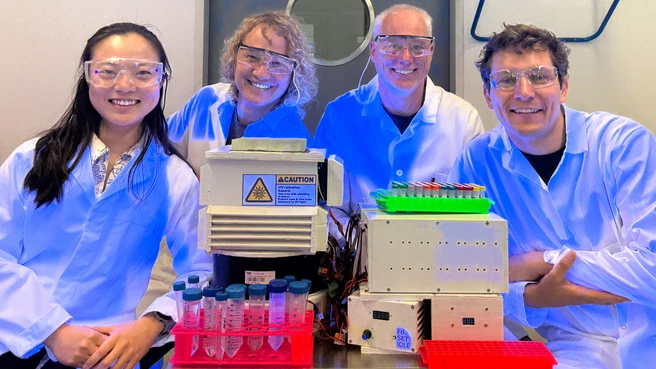In order for proteins to fulfill their diverse functions in the human body, they need information from the DNA. To be able to read this information, they must come into direct contact with the DNA. However, which proteins bind directly to the DNA molecule has not yet been well researched. A team of TUM researchers has now developed a method to detect direct protein-DNA interaction for almost two thousand proteins simultaneously. They have published their results in a study in “Cell”.
How black light is used in proteomics
Long-wave UV light, well known as black light from bars and discos, is also used in research. Dr. Jakob Trendel, first author of the study and research associate at Bernhard Küster's Chair of Proteomics and Bioanalytics, explains: "UV light with a low wavelength is strongly absorbed by proteins, DNA and RNA and is therefore quickly harmful to the structure of a cell. Longer wavelength UV light is far less damaging to biomolecules and can therefore be used at very high intensities."
Trendel and his team use an LED-based black light lamp and an artificial DNA building block. Cell cultures incorporate this building block into their DNA molecules and the black light activates it without harming the cells. This opens up new possibilities for future investigations because DNA-binding proteins can be studied in their natural environment.
DNA snipplet reveals contact in living cells
But how does the light ensure that the contact between DNA and protein can be detected? Jakob Trendel explains: "We feed cells with an artificial DNA building block that we can activate with black light. Proteins that bind directly to the DNA are thereby linked to it. Proteins that have touched the DNA carry a piece of this DNA with them. For us, this is evidence of the contact and also shows us which part of the peptide sequence a protein has used for this contact."
Reaction of hundreds of proteins to breast cancer DNA discovered
The research team has already tested the method on breast cancer cells in the laboratory. These cells respond to estrogen by means of a specialized receptor protein that recognizes the hormone, binds to the DNA, and activates genetic programs. In addition to this protein, the research team was able to identify DNA binding in 1,800 other proteins, of which over a hundred responded to the hormone signal. Now these relationships can be investigated not only with estrogen, but also with completely different active substances.
Jakob Trendel says of the new possibilities this opens up: “In the future, we will use this method to investigate and improve the effect of chemotherapeutic agents on cancer cells. In addition to substances that actively damage DNA, epigenetic agents are of particular interest. Their goal is to alter DNA binding through chemical modifications to DNA or proteins.”
More Information
The original publication in “Cell”: The human proteome with direct physical access to DNA. Cell May 22, 2025 (open access). DOI: 10.1016/j.cell.2025.04.037
